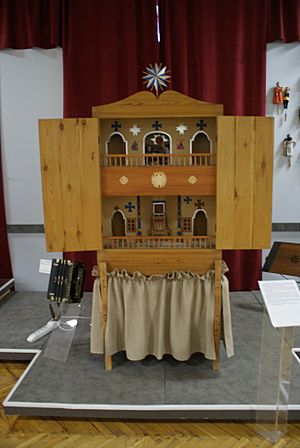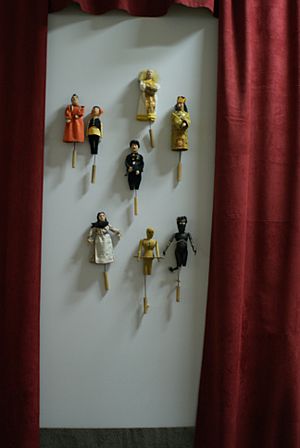Batlejka facts for kids
Batlejka (also spelled Batleyka) is a special kind of puppet theatre from Belarus. Its name comes from the city of Bethlehem. These shows are usually performed around the Christmas time.
This unique puppet theatre became popular in Belarus during the 16th century. It was most famous in the 18th and 19th centuries. For a while, during the Soviet era, people didn't perform Batlejka much. But now, it's making a big comeback in Belarus and among Belarusians living in other countries.
Contents
What is a Batlejka Show Like?
Imagine a mini stage, often made of wood, with small doors. This is the Batlejka booth! The puppeteer hides behind it and moves the puppets.
The Batlejka Stage
The puppet stage has two levels:
- The upper level is often called the 'heavenly' or 'canonical' level. This is where religious characters appear.
- The lower level is the 'earthly' or 'layman' level. This is where everyday people and funny scenes take place.
The Puppets
The puppets themselves are usually made from wood. They wear tiny, colourful clothes, making them look like miniature people. Puppeteers move them using thin metal rods.
What Stories Do Batlejka Shows Tell?
Batlejka performances usually have two main parts. One part tells a classic story, and the other part is full of funny, everyday adventures.
Part 1: The Christmas Story
This part tells the story of Christmas.
- King Herod hears from the Three Kings that a new king, the Saviour, has been born.
- King Herod worries this new king will take his place. So, he orders a soldier to go to Bethlehem and harm all the newborn babies.
- The soldier follows the order. But one baby, Rachael's baby, is saved.
- An angry King Herod then orders Rachael's baby to be harmed too.
- Because of his bad deeds, King Herod is taken to a dark place by the Devil. The soldier who followed his orders soon follows him.
Part 2: Funny Folk Scenes
This second part is very different! It's full of humorous and sometimes silly stories.
- These scenes feature many different characters. You might see peasants, shopkeepers, or even important people from the past.
- While the Christmas story (Part 1) was mostly the same everywhere, the folk scenes (Part 2) could be very different.
- The stories in Part 2 often changed depending on where the show was performed. They also depended on the imagination of the puppeteer!




